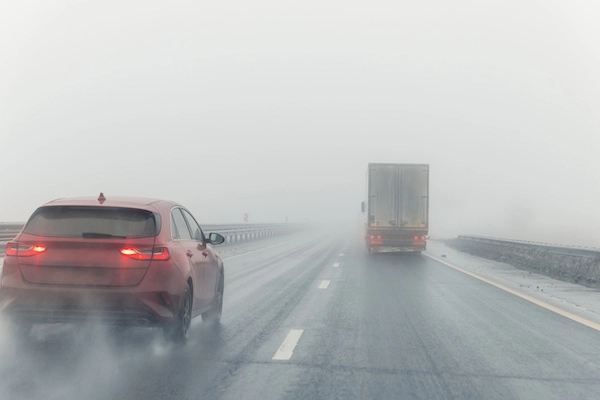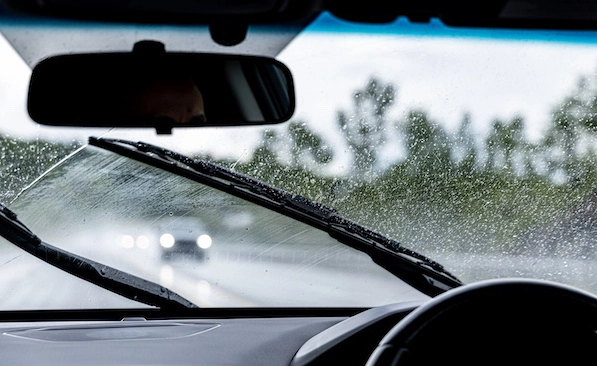How to Drive in Wind, Fog, Rain & Ice
Published on: Monday, 30 October 2023 | Author: Jack Dreyer
The UK is well placed for a comparatively temperate climate: we don’t have dangerously hot summers or long stretches of winter well below zero. But, while it’s not the Sahara desert or the depths of Greenland, we’re also no strangers to a spot of bad weather. It might not be extreme, but it sure does feel constant.
Driving in bad weather, then, is something that we just have to get used to all over Britain – but it’s also something that can be really scary to begin with.
If there happen to be any weather warnings, we’d advise that you don’t drive – but if you’re forced to drive in bad weather, here are some tips.
Adverse weather conditions usually require the same cautions
To begin with, whether it’s raining, icy, or extremely windy, you’ll usually have to use the same caution because, fundamentally, weather conditions adversely affect either (or both) visibility and stopping ability. The fact that they affect these to different degrees (for example, ice is slipperier than rain) doesn’t necessitate different advice but the following advice to different degrees.
1. Slow down
In all adverse conditions, slowing down is the first and most important step because it’ll significantly improve your ability to brake properly when you need to.
You need to slow down relative to the intensity of the conditions.
For example, if it’s extremely windy, you may assume that your car is able to maintain its usual grip with the road because the road itself isn’t slippery. But strong gusts of wind can more easily move your car sideways if you’re going at speed. We don’t need to get into the physics of this but, when you’re travelling at speed, there’s less grip with the road so a lot less resistance to sideways forces.
In icy or wet conditions, stopping can take more than 10 times longer than stopping from the same speed in dry conditions. So, slowing down helps maintain your wheels’ grip on the road, improves your stopping distance, and gives you more time to react to oncoming hazards.
What’s more, there’s a hugely increased risk of aquaplaning when driving over standing water at speed. This is where the tread patterns of your tyres can’t remove water from the road surface fast enough – so you end up skidding over the surface of the water.
Slowing down also comes hand in hand with driving smoothly. Don’t get to speeds where you’ll have to brake harshly and try not to pull away from junctions at speed.
2. Leave room between you and the cars in front
Slowing down also means leaving much more room between yourself and the cars in front. Driving really closely behind other cars gives you essentially no time to react to danger – and can also stress drivers out to the point that they make a mistake and create danger.
Leave at least two car lengths, but preferably more if the conditions are extremely rainy or at all icy.

3. Look far ahead & be mindful of your surroundings
Where visibility allows (like when not driving in fog), be sure to look well ahead of you while also being mindful of your surroundings. You can be driving perfectly sensibly, but other road users could be approaching oncoming junctions at dangerous speeds.
This also applies to being aware of all possible hazards, not just other drivers. In extreme wind, for example, trees can be uprooted, branches can break off trees, tiles can come off roofs, and other debris can be blown onto the road from places where you wouldn’t usually think to look for hazards.
Being aware of what’s ahead gives you ample time to react to problems.
4. Maintain a firm grip on the steering wheel
This is especially the case for driving in extreme wind, but also applies to any time that the road surface gets more slippery. Maintaining a firm grip on the steering wheel lets you stay more in control of unexpected movement during sudden gusts or times when your wheels aren’t gripping the road properly.
5. Use appropriate headlights & hazards for the conditions
Using the appropriate headlights for the conditions is also crucial when driving in bad weather. This doesn’t only apply at night time but at any time when visibility is reduced.
This means using fog lights in fog, full beams during heavy rain, and hazards during heavy precipitation that reduces visibility and forces everyone to drive slowly. The appropriate headlights are also not just so that you can see, but so that you can be seen.

Make sure your car’s in good working order
You can drive as sensibly as possible in bad weather, but a car not fit for driving in that weather is going to make life a whole lot harder.
Be sure to get regular servicing and checks at your local Tyre Pros centre so that your brakes, tyres, suspension, and headlights are always in great condition.




